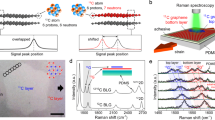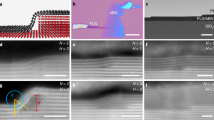Abstract
The quest for materials capable of realizing the next generation of electronic and photonic devices continues to fuel research on the electronic, optical and vibrational properties of graphene. Few-layer graphene (FLG) flakes with less than ten layers each show a distinctive band structure. Thus, there is an increasing interest in the physics and applications of FLGs. Raman spectroscopy is one of the most useful and versatile tools to probe graphene samples. Here, we uncover the interlayer shear mode of FLGs, ranging from bilayer graphene (BLG) to bulk graphite, and suggest that the corresponding Raman peak measures the interlayer coupling. This peak scales from ~43 cm−1 in bulk graphite to ~31 cm−1 in BLG. Its low energy makes it sensitive to near-Dirac point quasiparticles. Similar shear modes are expected in all layered materials, providing a direct probe of interlayer interactions.
This is a preview of subscription content, access via your institution
Access options
Subscribe to this journal
Receive 12 print issues and online access
$259.00 per year
only $21.58 per issue
Buy this article
- Purchase on Springer Link
- Instant access to full article PDF
Prices may be subject to local taxes which are calculated during checkout




Similar content being viewed by others
References
Geim, A. K. & Novoselov, K. S. The rise of graphene. Nature Mater. 6, 183–191 (2007).
Bonaccorso, F., Sun, Z., Hasan, T. & Ferrari, A. C. Graphene photonics and optoelectronics. Nature Photon. 4, 611–622 (2010).
Castro, E.V. et al. Biased bilayer graphene: Semiconductor with a gap tunable by the electric field effect. Phys. Rev. Lett. 99, 216802 (2007).
Taychatanapat, T., Watanabe, K., Taniguchi, T. & Jarillo-Herrero, P. Quantum Hall effect and Landau level crossing of Dirac fermions in trilayer graphene. Nature Phys. 7, 621–625 (2011).
Guinea, F., Castro Neto, A. H. & Peres, N. M. R. Electronic states and Landau levels in graphene stacks. Phys. Rev. B 73, 245426 (2006).
Koshino, M. & Ando, T. Electronic structures and optical absorption of multilayer graphenes. Solid State Commun. 149, 1123–1127 (2009).
Lui, C. H. et al. Imaging stacking order in few-layer graphene. Nano Lett. 11, 164–169 (2010).
Zhu, W., Perebeinos, V., Freitag, M. & Avouris, P. Carrier scattering, mobilities, and electrostatic potential in monolayer, bilayer, and trilayer graphene. Phys. Rev. B 80, 235402 (2009).
Ye, J. T. et al. Accessing the transport properties of graphene and its multilayers at high carrier density. Proc. Natl Acad. Sci. USA 108, 13002–13006 (2011).
Nair, R. R. et al. Fine structure constant defines visual transparency of graphene. Science 320, 1308 (2008).
Bae, S. et al. Roll-to-roll production of 30-inch graphene films for transparent electrodes. Nature Nanotech. 5, 574–578 (2010).
Latil, S., Meunier, V. & Henrard, L. Massless fermions in multilayer graphitic systems with misoriented layers: Ab initio calculations and experimental fingerprints. Phys. Rev. B 76, 201402(R) (2007).
Ferrari, A. C. et al. Raman spectrum of graphene and graphene layers. Phys. Rev. Lett. 97, 187401 (2006).
Ferrari, A. C. Raman spectroscopy of graphene and graphite: Disorder, electron–phonon coupling, doping and nonadiabatic effects. Solid State Commun. 143, 47–57 (2007).
Yu, P. Y. & Cardona, M. Fundamentals of Semiconductors: Physics and Materials Properties 3rd edn (Springer, 2003).
Nemanich, R. J., G Lucovsky, G. & Solin, S. A. Infrared active optical vibrations of graphite. Solid State Commun. 23, 117–120 (1977).
Mani, K. K. & Ramani, R. Lattice dynamics of graphite. Phys. Status Solidi B 61, 659–668 (1974).
Ferrari, A. C. & Robertson, J. (eds) Raman spectroscopy in carbons: From nanotubes to diamond. Phil. Trans. R. Soc. A 362, 2267–2565 (2004).
Nemanich, R. J., Lucovsky, G. & Solin, S. A. in Proceedings of the International Conference on Lattice Dynamics (ed. Balkanski, M.) (Flammarion, 1975).
Hanftand, M., Beister, H. & Syassen, K. Graphite under pressure: Equation of state and first-order Raman modes. Phys. Rev. B 39, 12598–12603 (1989).
Sinha, K. & Menéndez, J. First- and second-order resonant Raman scattering in graphite. Phys. Rev. B 41, 10845–10847 (1990).
Novoselov, K. S. et al. Electric field effect in atomically thin carbon films. Science 306, 666–669 (2004).
Blake, P. et al. Making graphene visible. Appl. Phys. Lett. 91, 063124 (2007).
Casiraghi, C. et al. Rayleigh imaging of graphene and graphene layers. Nano Lett. 7, 2711–2717 (2007).
Chandrasekhart, M., Cardona, M. & Kane, E. O. Intraband Raman scattering by free carriers in heavily doped n-Si. Phys. Rev. B 16, 3579–3595 (1977).
Tan, P. H., Deng, Y. M. & Zhao, Q. Temperature-dependent Raman spectra and anomalous Raman phenomenon of highly oriented pyrolytic graphite. Phys. Rev. B 58, 5435–5439 (1998).
Tan, P. H. et al. Probing the phonon dispersion relations of graphite from the double-resonance process of Stokes and anti-Stokes Raman scatterings in multiwalled carbon nanotubes. Phys. Rev. B 66, 245410 (2002).
Toulouse, J., Colonna, F. & Savin, A. Long-range-short-range separation of the electron–electron interaction in density-functional theory. Phys. Rev. A 70, 062505 (2004).
Lebègue, S. et al. Cohesive properties and asymptotics of the dispersion interaction in graphite by the random phase approximation. Phys. Rev. Lett. 105, 196401 (2010).
Mounet, N. & Marzari, N. First-principles determination of the structural, vibrational and thermodynamic properties of diamond, graphite, and derivatives. Phys. Rev. B 71, 205214 (2005).
Carpinteri, A. Structural Mechanics: A Unified Approach 200–236, 286–331 (Spon, 1997).
Grimsditch, M. Shear elastic modulus of graphite. J. Phys. C 16, L143 (1983).
Bosak, A. & Krisch, M. Elasticity of single-crystalline graphite: Inelastic X-ray scattering study. Phys. Rev. B 75, 153408 (2007).
Lazzeri, M., Piscanec, S., Mauri, F., Ferrari, A. C. & Robertson, J. Phonon linewidths and electron–phonon coupling in graphite and nanotubes. Phys. Rev. B 73, 155426 (2006).
Pisana, S. et al. Breakdown of the adiabatic Born–Oppenheimer approximation in graphene. Nature Mater. 6, 198–201 (2007).
Bonini, N., Lazzeri, M., Marzari, N. & Mauri, F. Phonon anharmonicities in graphite and graphene. Phys. Rev. Lett. 99, 176802 (2007).
Klein, M. V. in Light Scattering in Solids, Topics in Applied Physics 2nd edn Vol. 8 (ed. Cardona, M.) (Springer, 1975).
Dresselhaus, M. S. & Dresselhaus, G. in Light Scattering in Solids III (eds Cardona, M. & Güntherodt, G.) (Springer, 1982).
Casiraghi, C. et al. Raman fingerprint of charged impurities in graphene. Appl. Phys. Lett. 91, 233108 (2007).
Zhao, W. J., Tan, P. H., Liu, J. & Ferrari, A. C. Intercalation of few-layer graphite flakes with FeCl3: Raman determination of Fermi level, layer by layer decoupling, and stability. J. Am. Chem. Soc. 133, 5941–5946 (2011).
Coleman, J. N. et al. Two-dimensional nanosheets produced by liquid exfoliation of layered materials. Science 331, 568–571 (2011).
Noffsinger, J. et al. EPW: A program for calculating the electron–photon coupling using maximally localized Wannier functions. Comput. Phys. Commun. 181, 2140–2148 (2010).
Thonhauser, T. et al. Van der Waals density functional: Self-consistent potential and the nature of the van der Waals bond. Phys. Rev. B 76, 125112 (2007).
Basko, D. M., Piscanec, S. & Ferrari, A. C. Electron–electron interactions and doping dependence of the two-phonon Raman intensity in graphene. Phys. Rev. B 80, 165413 (2009).
Acknowledgements
We thank E. McCann, M. Koshino and T. Thonhauser for useful discussions. This work was supported by the National Basic Research Program of China (973 Program) Grant No. G2009CB929301; National Science Foundation of China grants 10934007, 10874177, 10874175, 60878025; European Research Council grants NANOPOTS and BIHSNAM; Engineering and Physical Sciences Research Council grant EP/G042357/1; a Royal Society Wolfson Research Merit Award; European Union grants RODIN and Marie Curie ITN-GENIUS (PITN- GA-2010-264694); and Nokia Research Centre, Cambridge.
Author information
Authors and Affiliations
Contributions
A.C.F. and P.H.T. conceived the project. P.H.T. designed the measurement set-up. P.H.T., W.P.H., W.J.Z and A.L. prepared the samples and performed spectroscopic measurements and analysis. N.B., N.M., G.S., Z.H.W., H.W., K.C., Y.F.W., N.P., P.H.T. and A.C.F. performed ab initio calculations and analytic modelling. A.C.F., P.H.T., N.B. and N.M. wrote the paper.
Corresponding authors
Ethics declarations
Competing interests
The authors declare no competing financial interests.
Rights and permissions
About this article
Cite this article
Tan, P., Han, W., Zhao, W. et al. The shear mode of multilayer graphene. Nature Mater 11, 294–300 (2012). https://doi.org/10.1038/nmat3245
Received:
Accepted:
Published:
Issue Date:
DOI: https://doi.org/10.1038/nmat3245
This article is cited by
-
Quantum interference between dark-excitons and zone-edged acoustic phonons in few-layer WS2
Nature Communications (2023)
-
Direct characterization of shear phonons in layered materials by mechano-Raman spectroscopy
Nature Photonics (2023)
-
Exploring the tribological properties of PA6/GO nanocomposites produced by in situ polymerization
Journal of Materials Science (2023)
-
Electron-phonon coupling and vibrational properties of size-selected linear carbon chains by resonance Raman scattering
Nature Communications (2022)
-
Ultrafast coherent interlayer phonon dynamics in atomically thin layers of MnBi2Te4
npj Quantum Materials (2022)



